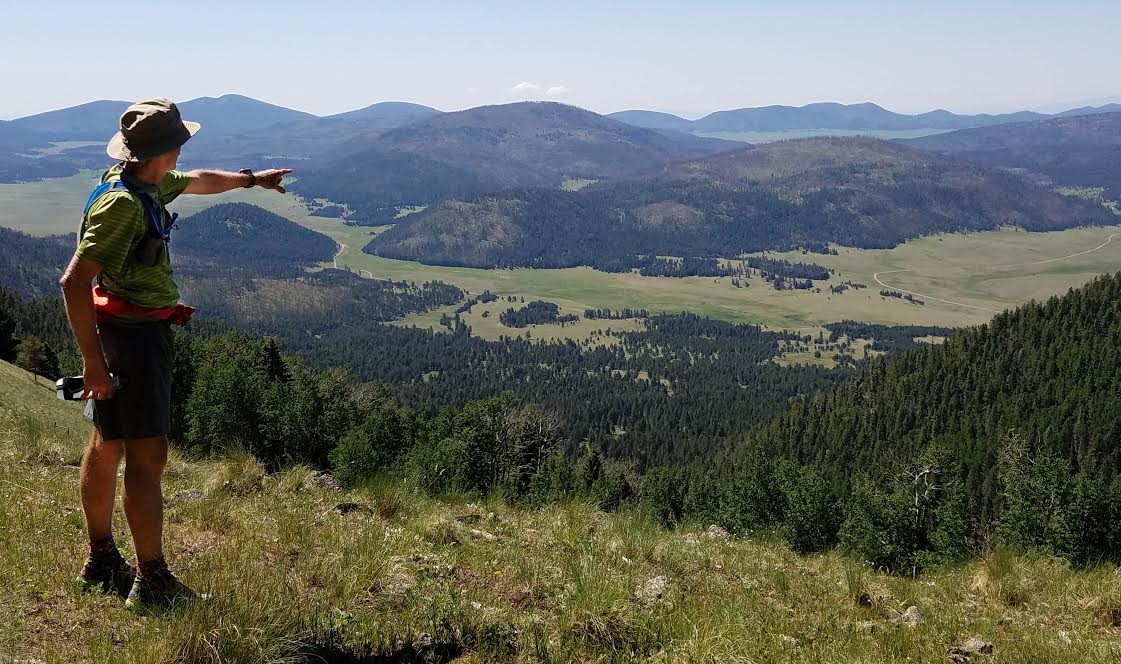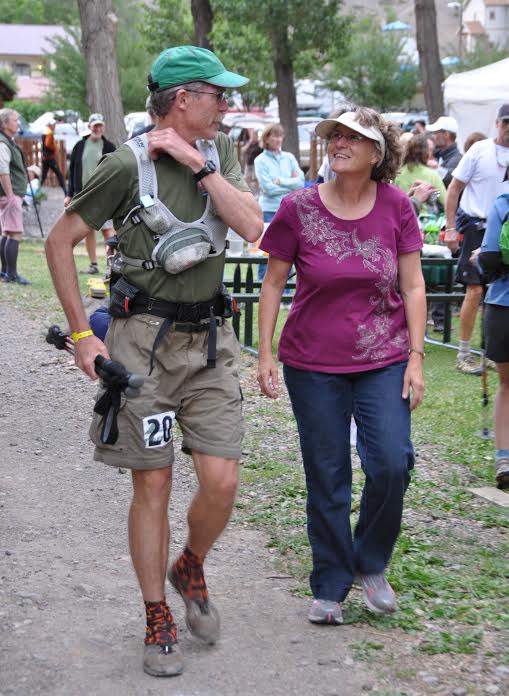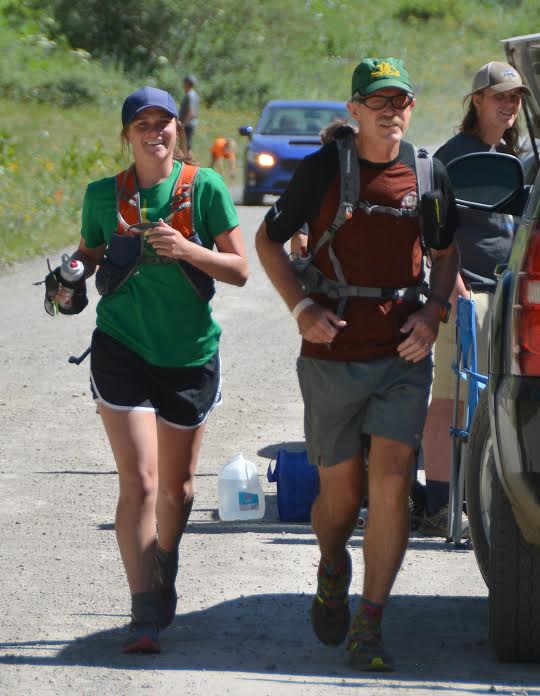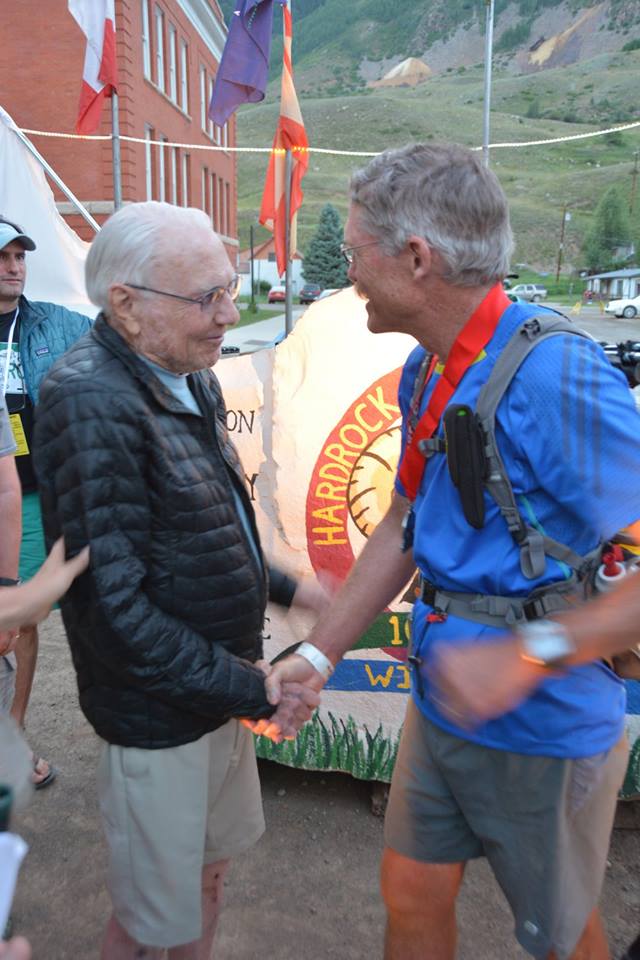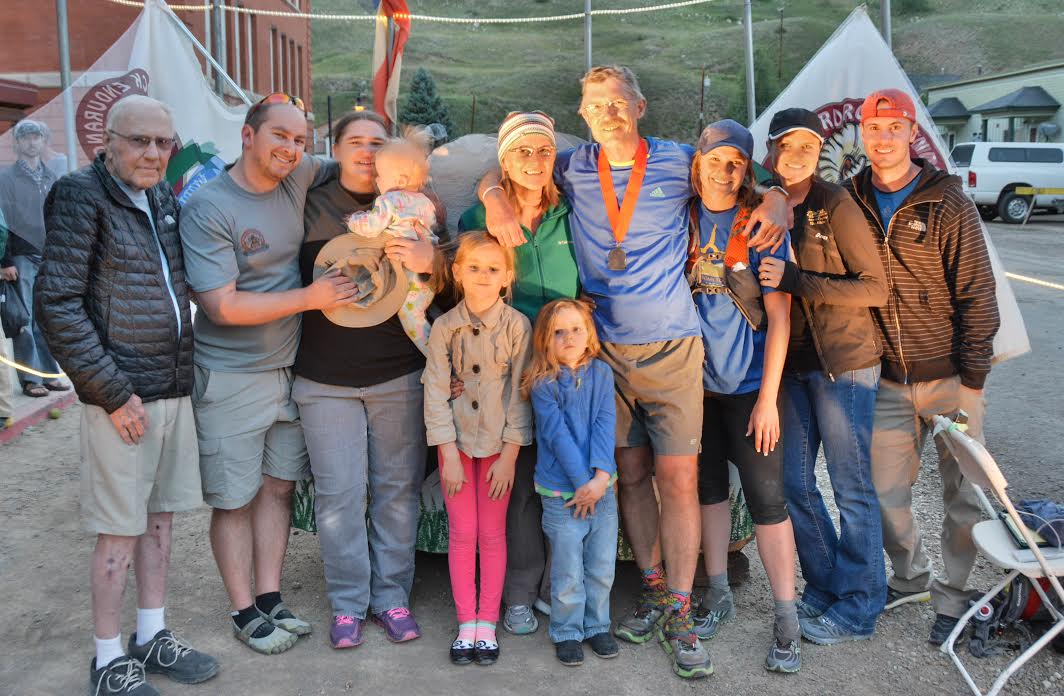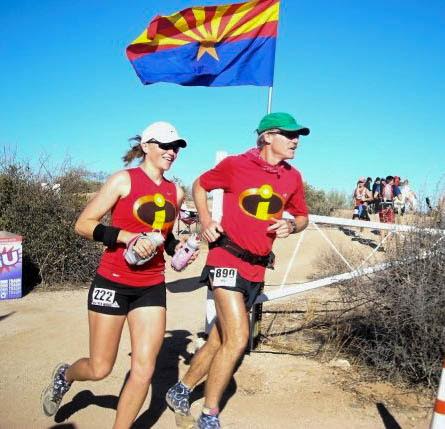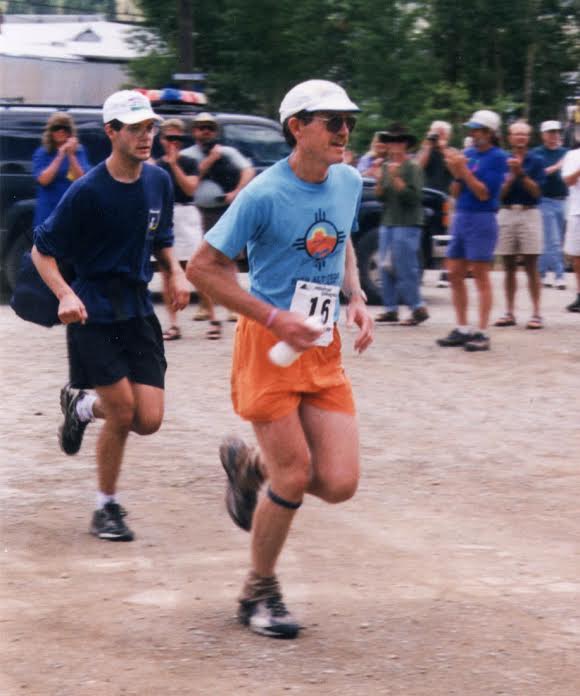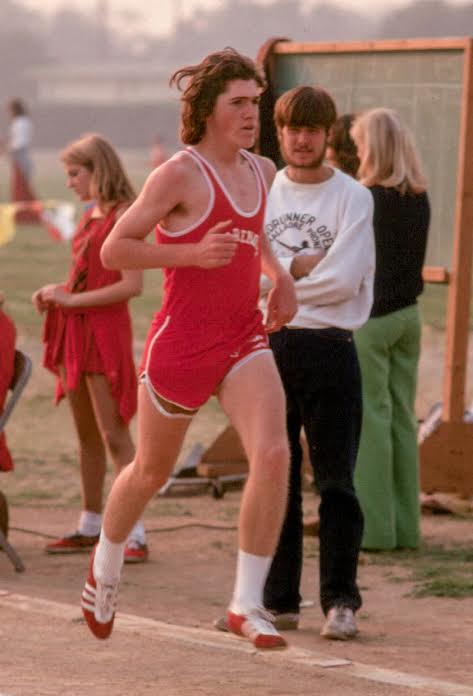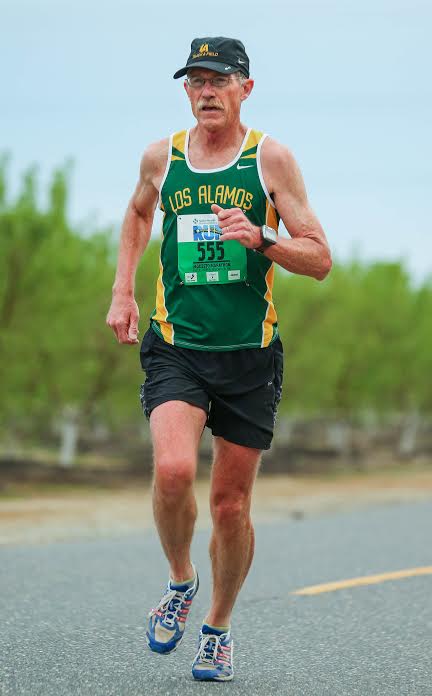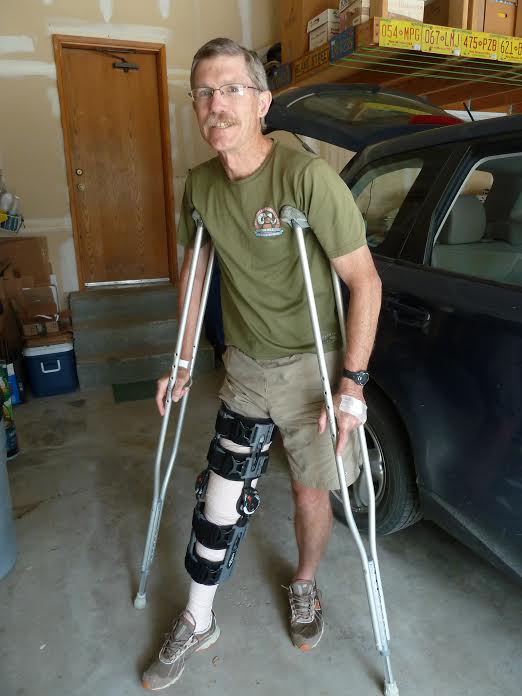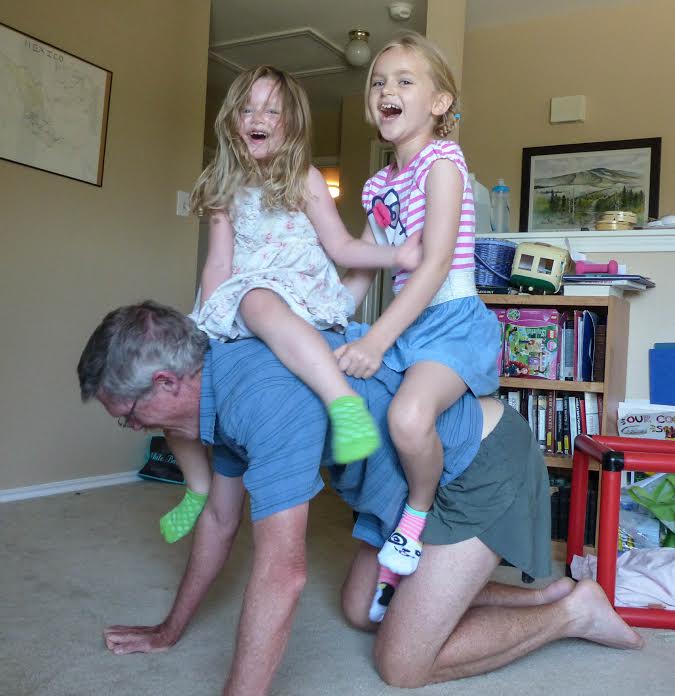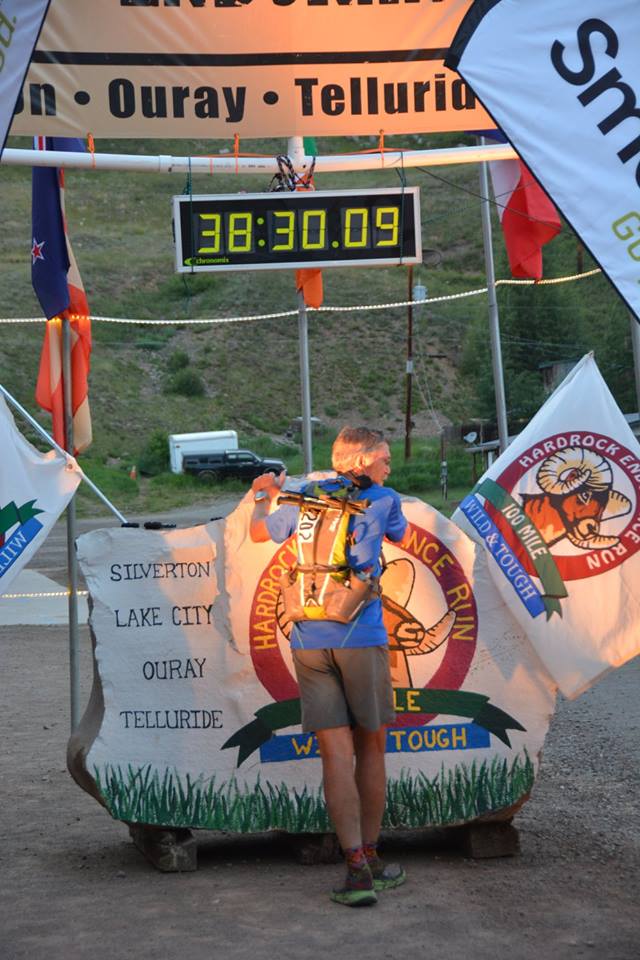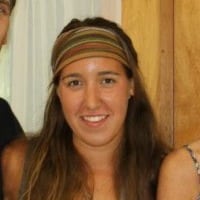Have you ever read the “Hardrock 100 at a Glance” note on the Hardrock 100 Mile Endurance Run website?
“100-mile run with 33,050 feet of climb and 33,050 feet of descent for a total elevation change of 66,100 feet with an average elevation of 11,186 feet – low point 7,680 feet (Ouray) and high point 14,048 feet (Handies Peak).”
Have you ever met Blake Wood, former Hardrock 100 course-record holder and Hardrock Board of Directors President?
“Fifty-eight-year-old male runner with 55 UltraSignup events and record holder of the longest stretch between sub-three-hour marathons for a total of more than 100,000 miles–beginning at age 15 and heading into his 21st Hardrock 100 finish.”

Blake Wood (right) being paced out of Ouray, Colorado by his father, Phil Wood, in his first 100 miler, the 1994 Hardrock. All photos courtesy of Blake Wood unless otherwise noted.
Blake Wood is one of those names associated with one event, the Hardrock 100. His first introduction to the mountainous land was the night before the 1994 event. It was his first 100-mile run.
“It was pretty sobering, lying there in a sleeping bag, looking at the stars and the mountains around me,” he said. “I was thinking, I have to go higher than the tops of the mountains I can see around me a dozen times. What did I get myself into?”
Wood is originally from southern California and started running as a sophomore in high school. As if it was yesterday, he remembers finishing up his first five-mile run with the team and saying, “Yeah, this is the right sport for me.”
He walked onto the running team at University of California, Santa Barbara, but after breaking his ankle his freshman year, he decided to not rejoin the team and just keep running as his own thing. Plus, the extra time not running helped his studies toward an electrical-engineering degree. He then went onto grad school at the University of California, Berkeley for both a masters degree and a PhD in electrical engineering and nonlinear dynamics and plasma physics. While in grad school, Blake and his wife, Rebecca, had already begun growing their family, three daughters. When he attended a conference in Los Alamos, New Mexico, he called his wife the after the first day and said, “This is the place we are going to live.”
Blake worked in Los Alamos National Laboratory designing and programming nuclear weapons. He recently retired, but his son-in-law and one of his daughters both work there and he goes in from time to time.
“Los Alamos is the land of the mountains,” Blake said. “If you are a runner, this is the greatest place to live. The mountains are beautiful and there is not one house that is more than five minutes from a trail and when you get on the trail, you can literally run for days without ever crossing the road.”
The town sits at 7,000 feet altitude and the mountains reach up to 10,000 feet. It is small, with only about 11,000 people, many of whom work in the lab. Between his job and being a cross-country and track coach for the local high school for the last 18 years, Blake and his family know about everyone in town.
“I worked with the parents of the kids I coached,” he explained. “I also coached my daughters’ husbands, who now work in the lab.”
Running is a big part of the Wood household. When Blake started years ago, his passion and joy inspired his father to quit smoking and join him. His father then went on to pace him at several ultras.
Of his own daughters, Jeanine Wood, the oldest, sprints and throws, but the younger two, Heather McNiff and Margaret Wood, are talented distance runners, with Margaret running at Colorado State University and Heather having competed in the 2012 Olympic Marathon Trials.
“Definitely a family thing,” he said, laughing. The youngest have run ultras and are usually Blake’s pacers at races.
Having been a fast marathoner through his early twenties, it was when he moved to Los Alamos that he was pulled into the ultra world. He ran a local ultra in Los Alamos, but it was the Jemez Mountain Trail Runs, a 50-mile, 50k, and 15-mile race which has now become a weekend of races that all Wood family members partake in every year.
Rebecca and Blake help manage the race and take on the post-race responsibilities.
Endurance was not uncommon for Blake, who would go on long adventure-like hikes with his dad, so the Jemez 50 Mile wasn’t too much of a shock.
“They are pretty ambitious runs,” he admitted. “You go up and down some pretty big mountains.”
It was at this race that he started meeting some of the local ultrarunning guys like Charlie Thorn and John Cappis. The two were the founders of Hardrock and after Blake told them he could not get into the sold-out Leadville Trail 100 Mile that year, they invited him to the third running of Hardrock.
“I asked, ‘Don’t you have to have done a hundred before that?’ and they said, ‘Eh, we have seen you run. We know you can do it,’” he recalled. “So I signed up for Hardrock, which was my first 100 miler. That was in 1994 and I have done it almost every year since.”
Only one year did he miss the event; in 2015 he busted his knee and had surgery, leading him to miss the July start date.
Next week’s event will be his 21st Hardrock.
Hardrock, like so many others, appealed to Blake for the mountains, the adventure, and the Hardrock family you enter into.
After his first finish, Cappis came up to him and asked Blake to be on the Hardrock organizing committee, which has now transformed into the event’s Board of Directors. Before, the informal group of Hardrock originals would meet together to look at entries and organize aid-station plans. Today the formalized group takes on the 1,900 entries, a lottery system, and the growing popularity of the run.
Blake spent a few years as Vice President, and then eight more as the President of the board before passing on the honor about five years ago.
“I was going to step off the board altogether and let somebody else be there, but they made me the first board emeritus member,” he said. “So, I am still part of it and I am welcome to the meetings and they are interested in my opinion because I have the historical knowledge of why we do things.”
Over the years, the Hardrock family has fought hard to keep the run as close to those first few years as possible. As elites flock to enter and the number of lottery entrants far exceeds the number of open spots, Blake said keeping Hardrock “Hardrock” has been the most difficult and interesting thing to watch over the years.
Those first few years, you could sign up the day of, like a typical 10k,” he said. “There were two years when our numbers went down from the previous year. And then it just took off.”
The board had to design, with much help from Blake, a lottery fair enough to keep the essence of the original event while allowing new and fast people onto the Hardrock course.
With the number of entrants doubling every three years, how do you keep Hardrock the same event that you come to every year to see your old buddies, the old timers who have done it a bunch of times? And how do you keep it fair and balanced to let in new people–from fast runners to the back of the pack?
Last year, there were 13 people for every slot open, so nearly 2,000 people wanting to get into a 145-person event.
“We have spent an enormous amount of time figuring that balance out,” he said.
For most, the lottery system is unfair and horrible, and to others, it is great and genius, he explained. Hardrock could easily be the elite mountain championship race of the world, but the organizers and true believers of Hardrock don’t want that.
They want to head into Silverton and see the guys they were running with 15 or 20 years ago. They want to ask how Blake’s daughters are, having seen them at high-school age and now, married. They want to ask how his wife is. And they also want to welcome new members into the Hardrock family with the same deep care as Hardrock’s earliest participants had for each other.
“It is the same course since day one, with some tweaks here and there,” he said. “We could make it 300 people, but it would not feel like Hardrock.”
The magic and uniqueness of the run would be lost, both out there on the course when trying to get through hundreds of bodies and navigating through crews and cars.
And come Sunday at the annual breakfast, where Run Director Dale Garland speaks about every runner from a notecard he made while watching each and every runner the day before… would that still be possible with a 300-plus runner race?
“We have no elite recognition. We pay no more attention to the winners than to the person who ends up in last place and that is a conscious decision on our part,” he said.
There is no podium and though we all want to see how fast Kilian Jornet goes or the race between runners, he said, the community watching at Hardrock also wants to see the mid-packers and back-of-the-pack runners.
“We know everyone, and it is run conducive toward people having interest in the entire pack,” he said. “And, that’s how we are going to keep it.”
For the families of the runners, like Blake’s daughters, many grow up watching Hardrock.
Heather was just seven years old when Blake first ran Hardrock, and it became a fun thing she and her sisters looked forward to every year.
“Back then, ultrarunning was much less popular and we had fun bragging to our friends that our dad was going to run a 100-mile race and seeing their shock and disbelief,” she said. “When I got old enough and got into running myself, I started to think I would someday run Hardrock.”
Heather raced the Javelina Jundred and Angeles Crest 100 Mile with Blake pacing her, and after finishing both, she realized the mountainous Hardrock course would not be for her.
Over the years of his own racing, Blake has had highs and lows (actually only one low) through the Hardrock terrain. He almost dropped out his second time, the 1996 run, having gone in with a slight injury. He planned on dropping at night, but a friend convinced him to take a nap first and decide afterward.
He woke up from a 30-minute nap, felt a bit better, and headed on, only to find himself at the next aid station wanting the exact thing: to drop. After another 45-minute nap, he woke up with the sun coming up. Meeting his dad who was to pace him to the end, the two ended up flying through the trails enjoying every step over the mountainous land, with the sun shining and the wildflowers popping out everywhere.
“That was an eye-opening experience,” he said. “I didn’t want to feel like crap and once I slowed it down and enjoyed myself, then I had a blast. It was eye opening that you can come back from feeling bad and then have a really good race.”
The 1999 Hardrock was the high point, when Blake came cruising into the finish area, winning the event and setting a then-course record of 30 hours and 10 minutes. The last two years, were neither high nor low. Out from surgery, Blake watched the 2015 run, and it was “definitely a different experience watching.”
“Just going to aid stations, watching people come through, watching my friends, watching the leaders come through… it was so much fun,” he said.
In 2016, he ran with the “okay, let’s just see if the knee holds up,” mentality, so this year, he knows will be different.
“This year I am feeling good.”
With a new, different style of training and a vengeance from the last two years, Blake is ready for July 14.
Typical training consisted of many miles, many mountain climbs, and many long runs during the weekends.
Because he ran Hardrock every year, Blake chose other races and adventures based on what seemed like fun other months of the year.
“I go with the flow,” he declared. “I always do the local Jemez races and Hardrock, but besides that I just make it up as I go.”
He usually took on high-mileage weeks of 100 miles when leading into races, such as his fastest 100-mile race, the 2002 Rocky Raccoon 100 Mile, where he finished in 14 hours and 51 minutes, and for the multiple times he took on The Barkley Marathons.
His first Barkley was in 1997, intrigued by the description he read. In 2001, he completed the fifth lap of the notorious race under the 60-hour time limit.
“That was a lot of fun because it was on the edge of what is possible,” he said.
What helps Blake accomplish these feats is his unwavering mental strength, plus a run-for-hours-alone personality.
“Every year I went into it thinking, This year for sure!” he said. “I never went to Barkley thinking I couldn’t finish.”
This is the mentality that spurred him into trekking the John Muir Trail alone in under five days in 1998, finishing in what was the then-fastest known time, he said. It was five days of river crossings and snow, trashing his feet, and making it an adventure he is proud to say he took on.
Blake also had a hand in configuring the best route of the Nolan’s 14. In 1999, he, Fred Vance, and Gordon Hardman became the first three people to attempt the Nolan’s 14, but trouble of several kinds meant they were unable to complete all 14.
It took three attempts, with many people then trying to create a route, to get it down fast and right. “There are still many variations depending on the strengths of the runner,” he said. “It was a lot of fun figuring it out and a very cool event. I am glad people are trying to take a shot at it again.”
So, with all this training up and down mountains, 100-mile weeks, long runs, etc, why is it now, for the 2017 Hardrock, that he feels will be one of his fastest years?
Since 15, Blake has always run marathons and road races. And, as a high-school cross-country coach for nearly 20 years, speed workouts were always completed a few times a week.
Yet, in the last few years, Blake’s training has become more geared to quality workouts, something he never concentrated on before.
It started with a record he came across that he had a shot at. It wasn’t a time per se, but more of a record of, Wow, this is a thing?
The record was the longest time span or number of years between sub-three-hour marathons. Having run his first sub-three as a sophomore in high school, he decided this past March to go for it.
He finished in 2:58:06 at the 2017 Modesto Marathon in California, earning him the record for the longest time between under three hours for a marathon. His record is 41 years. It was hard, he admitted, yet running marathon-fast speeds was something Blake was coming back to for his own training.
It started about six years ago when his daughter Heather was training for the Olympic Marathon Trials, aiming for a 2:46 marathon time. With workouts designed by her former college coach, she would call up her dad, asking him to worout with her.
“She would call and say, ‘Hey Dad, I have this monster workout today’–well it looked like a monster workout to me–‘Come do it with me.’” he said.
These workouts were things like 12 x one-mile repeats at six-minute pace at 7,000 feet altitude or 3 x three-mile repeats at the same pace, he remembered.
“I’d gulp and say, ‘Okay, I’ll come out and try to keep up with you…’ I discovered that I could keep up.”
“I feel so lucky that I get to run with my dad. He is the perfect running partner because he is always ready to go as far as you want at whatever pace you want and can take me places I would never go by myself (because I either didn’t know the trails were there or would have gotten lost),” Heather said.
Thanks to his great attitude and excitement for each workout, she said, Blake as a training partner was what she needed to train and qualify for the Trials. It was a great race, she said, and a great story to tell after.
The two did Grandma’s Marathon in 2011, and without knowing what to expect for his first fast marathon in 35 years, Blake’s goal was to just keep up with Heather for as long as he could. They finished in 2:43 with Heather earning a place in Los Angeles for the Trials after trying to outsprint her dad when they came in together.
The two ran mostly with a bunch of women also aiming for the same goal, and when they learned the man keeping up with them stride for stride was Heather’s father, they were blown away.
“As always, I felt so lucky and special that my dad could share special races like this with me,” she said. “Also, at the end of the race, we kicked for the finish (as much as you can at the end of a fast marathon) and he just out-leaned me to beat me. I tell people that story all the time because I think it is hilarious. Even though he is very low-key, he still has that competitive spirit and in all of the races we have run together or raced at the same time, he has never once let me beat him!”
For the record, the results log Blake one second ahead of Heather, 2:43:52 to 2:43:53.
For Blake, racing that marathon was like an epiphany, teaching him how certain workouts are appropriate for races.
“Doing them with my daughter and still running with the cross-country kids have made a big difference in my running,” he claimed, while boosting his secret desire to win.
Blake runs on the indoor track in the winter, still competes in road races when they pop up, and claims it is thanks to the mix of trails, miles, and speeds that has allowed him to keep running for 44 years.
“This kind of variety helps and doing different things every season keeps it from getting old week in and week out,” he said.

Blake running the age 55 to 59 one-mile race in the 2014 USATF Masters Indoor Track & Field National Championships.
Blake enjoys skiing and snowboarding in the winter with his daughter Margaret, who is a snowboard instructor.
“I think that I now get more out of workouts than I was getting 10 years ago and have a higher quality of workouts. Now that I am older, and slower, it is important to keep training that speed,” he said.
Now that he is retired, he has taken on more leisurely hobbies, and not so leisurely, He and his wife have a goal of finishing all of the 14ers in Colorado. So far, they have 44 of the 54 done. Blake also enjoys taking photos of his cross-country and track teams, and has done some weddings. He also just finished his 50th batch of homebrewed beer, a hobby passed down from his father and one he can devote more time to since retiring from the lab.
So, this year, Blake is taking everything: the endurance, the mountain running, the snowboarding, the speed workouts, the good beer, the experience and putting it all out on the Hardrock course once again.
“I am training hard,” he said. “I am feeling good. I am pretty much up to full strength, and I am feeling pretty bullish that this is going to be a good year.”
Keep your eyes out at Hardrock for Blake Wood.
Call for Comments (from Meghan)
What stories can you share about Blake Wood? From working and living with him in Los Alamos, New Mexico, to sharing the trails with him at Hardrock and other events, and more, leave a comment to share your Blake story!
